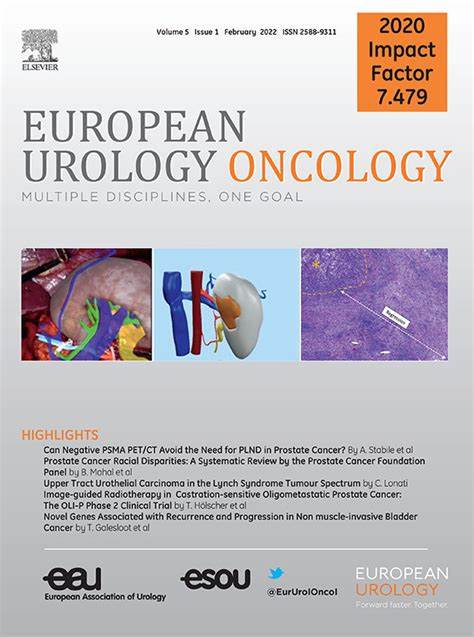前列腺癌的主动监测变得更安全了吗?从全球临床登记中汲取的经验教训。
IF 9.3
1区 医学
Q1 ONCOLOGY
引用次数: 0
摘要
背景和目的:主动监测(AS)已发展成为世界上许多低危前列腺癌(或部分中危病例)男性患者广泛采用的治疗策略。在此,我们报告了主动监测的安全性和可接受性,以及随访 6 年以上的 14 623 名男性低危和中危肿瘤的治疗效果:从 2000 年起,我们在国际数据库中收集了来自 15 个国家 25 个队列的 26999 名男性 AS 患者的临床数据:在我们预先设定的四个时间段中,每个时间段为4年(涵盖2000-2016年),总生存期(OS)没有显著变化。然而,无转移生存率(MFS)自第二个时间段以来有所提高,并且非常出色(>99%)。早期的无治疗生存率显示,向根治性治疗的转变稍快。随着时间的推移,因焦虑而改变治疗方案的男性比例一直保持在 5%。然而,也有 10%-15%的人改变了治疗方法,但没有明显的原因。在一部分男性(10%-15%)中,肿瘤进展是治疗的诱因。在选择根治性治疗的男性中,手术是最常见的治疗方式。在接受根治性治疗的男性中,90%在治疗后5年未出现生化复发:我们的研究证实,在这个长期随访的大型多中心队列中,在整个治疗期间,强直性脊柱炎是一种安全的治疗选择,因为10年后的OS和MFS分别为84.1%和99.4%;在最初患有低危肿瘤的男性中,10年后接受治疗的概率为20%,而在患有中危肿瘤的男性中,10年后接受治疗的概率为31%。新的诊断模式可能会提高采用个体风险评估进行随访的可接受性,同时安全地扩大主动监测在高风险肿瘤中的应用。患者摘要:主动监测(AS)已发展成为全球许多男性前列腺癌患者广泛采用的治疗策略。在这份报告中,我们展示了中低风险前列腺癌患者长期接受主动监测的安全性。我们的研究证实,强直性脊柱炎是一种安全的中低危前列腺癌治疗方法。新的诊断模式可能会提高采用个体风险评估进行随访的可接受性,同时安全地扩大强直性脊柱炎在高危肿瘤中的应用。本文章由计算机程序翻译,如有差异,请以英文原文为准。
Has Active Surveillance for Prostate Cancer Become Safer? Lessons Learned from a Global Clinical Registry
Background and objective
Active surveillance (AS) has evolved into a widely applied treatment strategy for many men around the world with low-risk prostate cancer (or in selected cases intermediate-risk disease). Here, we report on the safety and acceptability of AS, and treatment outcomes for low- and intermediate-risk tumours over time in 14 623 men with follow-up of over 6 yr.
Methods
Clinical data from 26 999 men on AS from 25 cohorts in 15 countries have been collected in an international database from 2000 onwards.
Key findings and limitations
Across our predefined four time periods of 4 yr each (covering the period 2000–2016), there was no significant change in overall survival (OS). However, metastasis-free survival (MFS) rates have improved since the second period and were excellent (>99%). Treatment-free survival rates for earlier periods showed a slightly more rapid shift to radical treatment. Over time, there was a constant proportion of 5% of men for whom anxiety was registered as the reason for treatment alteration. There was, however, also a subset of 10–15% in whom treatment was changed, for which no apparent reason was available. In a subset of men (10–15%), tumour progression was the trigger for treatment. In men who opted for radical treatment, surgery was the most common treatment modality. In those men who underwent radical treatment, 90% were free from biochemical recurrence at 5 yr after treatment.
Conclusions and clinical implications
Our study confirms that AS was a safe management option over the full duration in this large multicentre cohort with long-term follow-up, given the 84.1% OS and 99.4% MFS at 10 yr. The probability of treatment at 10 yr was 20% in men with initial low-risk tumours and 31% in men with intermediate-risk tumours. New diagnostic modalities may improve the acceptability of follow-up using individual risk assessments, while safely broadening the use of AS in higher-risk tumours.
Patient summary
Active surveillance (AS) has evolved into a widely applied treatment strategy for many men with prostate cancer around the world. In this report, we show the long-term safety of following AS for men with low- and intermediate-risk prostate cancer. Our study confirms AS as a safe management option for low- and intermediate-risk prostate cancer. New diagnostic modalities may improve the acceptability of follow-up using individual risk assessments, while safely broadening the use of AS in higher-risk tumours.
求助全文
通过发布文献求助,成功后即可免费获取论文全文。
去求助
来源期刊

European urology oncology
Multiple-
CiteScore
15.50
自引率
2.40%
发文量
128
审稿时长
20 days
期刊介绍:
Journal Name: European Urology Oncology
Affiliation: Official Journal of the European Association of Urology
Focus:
First official publication of the EAU fully devoted to the study of genitourinary malignancies
Aims to deliver high-quality research
Content:
Includes original articles, opinion piece editorials, and invited reviews
Covers clinical, basic, and translational research
Publication Frequency: Six times a year in electronic format
 求助内容:
求助内容: 应助结果提醒方式:
应助结果提醒方式:


